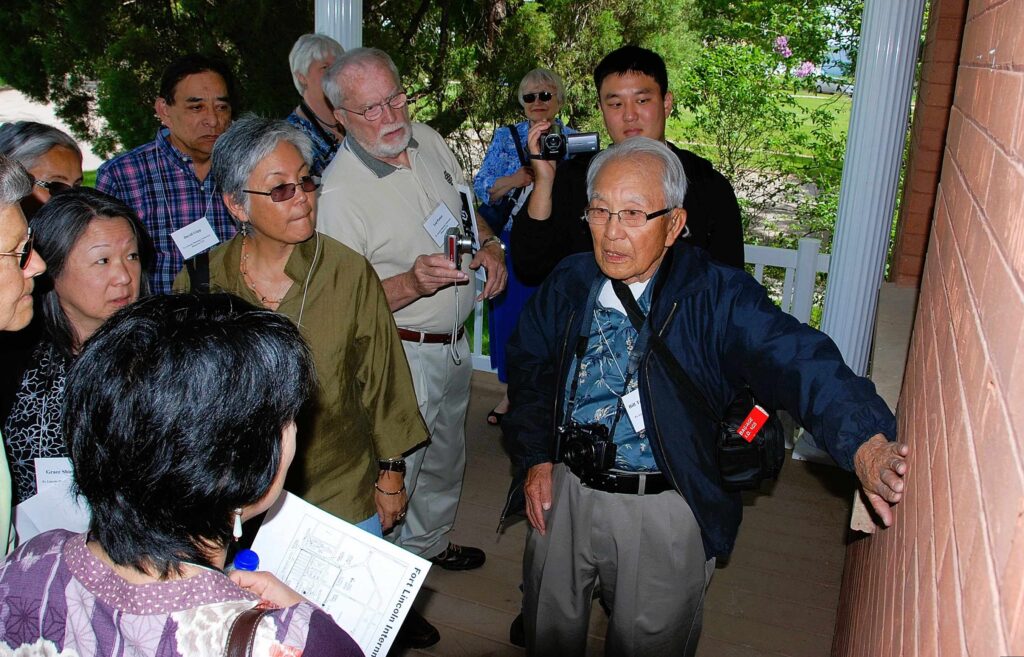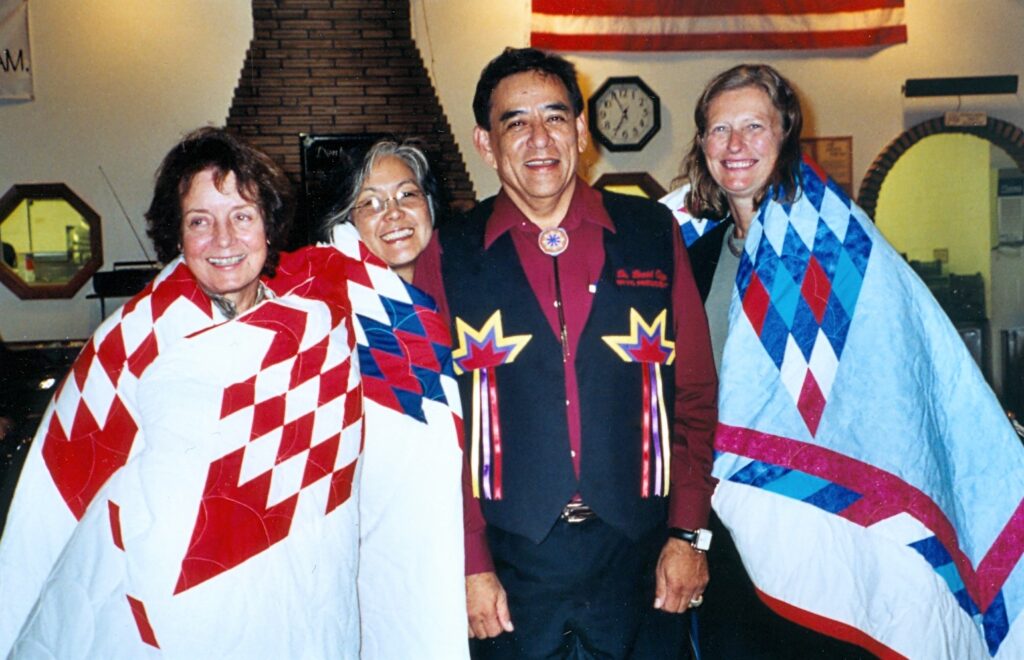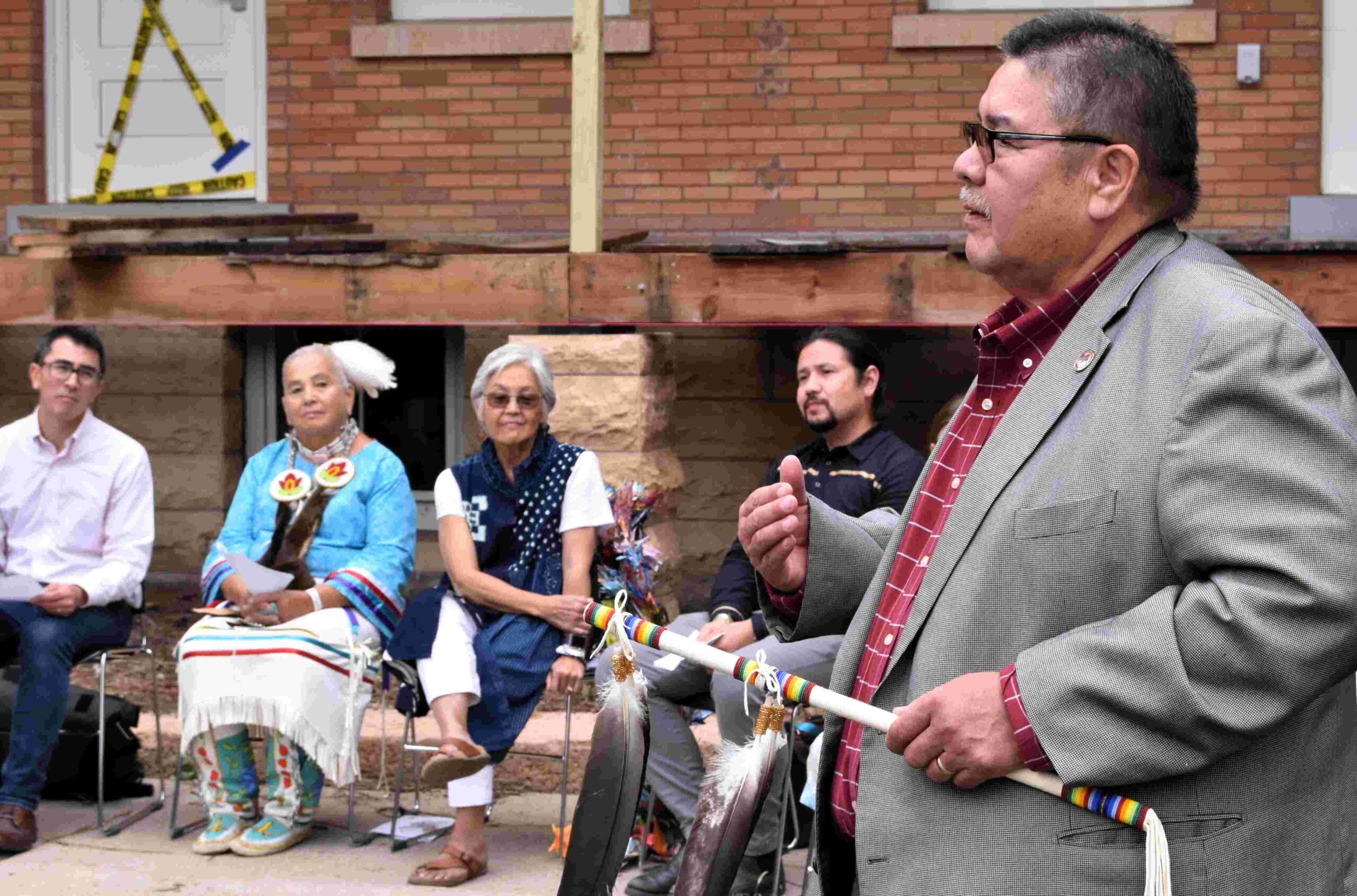January 4, 2024
In September, I had the privilege of attending the ground blessing ceremony for the Snow Country Prison Japanese American Internment Memorial on the campus of United Tribes Technical College (UTTC) in Bismarck, North Dakota. When completed, the memorial will bring much deserved attention to a unique World War II confinement site and a fascinating collaboration between Native American and Japanese American communities.
The Bismarck detention camp was built on the site of Fort Lincoln, a former military post. Run by the Immigration and Naturalization Service as one of dozens used to hold Japanese Americans during World War II, it held two separate sets of Nikkei detainees. In 1942, Bismarck was one of the three main longer-term detention facilities that held Issei community leaders arrested in West Coast states after the attack on Pearl Harbor, with over 1,100 internees arriving there in February 1942. After their hearings, these men were either paroled — in most cases to War Relocation Authority concentration camps — or transferred to other army or Justice Department-run internment camps, with nearly all having been transferred by the fall.
Beginning in early 1945, a second group of Nikkei prisoners were sent there, a group of around 750 dissidents from Tule Lake, about 650 of whom arrived in February, with another 100 arriving in July. Most were young Nisei and Kibei protesting their unconstitutional incarceration who had renounced their US citizenship under duress. Most of these men remained imprisoned at Bismarck through 1945, with most eventually deported to Japan and others transferred to the Santa Fe, New Mexico, or Crystal City, Texas, detention facilities.
In addition to the Japanese American prisoners, Bismarck also held enemy aliens of German descent as well as captured German seamen and POWs. In total, about 3,850 prisoners were held there during World War II. The camp closed on March 6, 1946.
“Men like my father, a Kibei who protested the unjust incarceration, were deemed ‘disloyal’ and punished by being separated from their families,” recalled Satsuki Ina, a member of the memorial’s advisory committee. “Interned as an ‘enemy alien,’ my father was held under indefinite detention at Bismarck to eventually be deported to Japan.”

After serving various functions in the postwar years, the former Fort Lincoln site intersected with the advent of the Tribal College Movement in the 1960s, whose efforts focused on building systems of Native leadership and governance over educational institutions serving Native people and students, addressing reservation economic development through job training, and also passing down Native cultures and skills. In this context, a coalition of North Dakota tribes obtained the Fort Lincoln site to establish the country’s second tribal college, dedicated in 1969. The college, which has an enrollment of around five hundred students and offers two and four year degrees, continues to be governed by the five North Dakota tribes: Sisseton-Wahpeton Oyate, Spirit Lake Nation, Standing Rock Sioux Tribe, Three Affiliated Tribes (Mandan, Hidatsa, and Arikara Nation) of the Fort Berthold Reservation, and Turtle Mountain Band of Chippewa. The student body is 95% Native American or Alaska Native, 75% low income, and 65% first generation college students.
The connection between the college and Japanese Americans was first established under the administration of legendary UTTC President David M. Gipp, who helmed the college from 1977 to 2014. While there was general knowledge in the Bismarck community about German internees at Fort Lincoln due to the fact that several settled in Bismarck after the war, there was little knowledge of the Japanese American internees, recalled Dennis Neumann, a longtime staff person at UTTC. Growing up in Bismarck, Neumann recalled his barber, a well-known figure in the local community, as being one of the German internees. According to Neumann, Japanese American former internees or their descendants began to visit the campus in the early 1980s, and Gipp would end up showing them around. Hearing the stories of the internee families, Gipp soon recognized, as he recalled in a 2003 speech, “the parallels that we have between internment and things like the American Indian boarding schools and the relocation of many of our people that took place.”
The first public acknowledgement of the Japanese American internment connection came with the 2003 exhibition Snow Country Prison: Interned in North Dakota, organized by the North Dakota Museum of Art and UTTC. It was also driven by the connection between Gipp, curator and museum director Laurel Reuter, and Satsuki Ina, who had chanced upon the site in 2000 and met Gipp while doing research for a film about her father’s internment at Fort Lincoln. The opening of the exhibition brought many internees and their families back to the site for the first time.

In the aftermath of the exhibition, Gipp recognized the need for “a place to welcome and orient visitors” to the internment camp site, recalled Neumann, who was the college’s public information director at that time. The college considered various possibilities for an interpretive/education center over the next decade or so, aided by a pair of grants from the Japanese American Confinement Sites grant program. But momentum for such a project waned with Gipp’s retirement.
The celebration of the college’s 50th anniversary in 2019 rekindled interest in such a project, led by Neumann and College Relations Director Brent Kleinjan with the full support of current College President Leander R. McDonald. UTTC received a 2020 JACS grant for the planning and design of an outdoor site to commemorate the internment camp that has led to plans for a memorial courtyard and wall that will contain the names of all of the Japanese American internees held at the site.
Representing Densho, I am part of an advisory group for the project that includes detention camp descendants Satsuki Ina, David Koda, and Barbara Takei, as well USC Professor Duncan Ryuken Williams. The group is working with MASS Design Group, a renowned non-profit architectural firm, in a team led by Joseph Kunkel, a Northern Cheyenne Nation member who directs MASS’s Sustainable Native Communities Design Lab and is based in Santa Fe, New Mexico, and Jeffrey Mansfield, a Japanese American who leads MASS’s Deaf Space and Disability Justice Lab.
“This Memorial bridges three bodies of work: Public Memory, Restorative Justice, and Sustainable Native Communities,” reads a statement from MASS. “Through a design that conveys the story of the Japanese American experience at Ft. Lincoln, we have also sought to catalyze a broader reconciliation process around intersectional and sustained systems of oppression in America.”

Beyond the confluence of Native American and Japanese American history, the Fort Lincoln site is a special one because it is one of only a handful of such sites where the buildings used to imprison Japanese Americans are still intact and in use. The courtyard where the memorial will be sited sits outside one of the brick barrack buildings where internees were imprisoned. It has been recently remodeled by the college, and includes classrooms, meeting rooms, and the college archive. The only other sites I can think of that have detention buildings intact and in use in their original location — Kiluaea Military Camp on the island of Hawai`i and the Grove Park and Assembly Inns in North Carolina, along with some prisons and jails used to briefly detain Issei community leaders — held far fewer Japanese American prisoners.
Fundraising is continuing for the memorial, and we hope to see it completed soon.
“This is important work, to not only recognize what happened to our Japanese American relatives, but to ourselves,” said current UTTC President Leander R. McDonald. “This memorial will show that we’re still here, that we’ve survived and that now we need to move ahead.”
—
By Brian Niiya, Densho Content Director
Special thanks to Dennis J. Neumann for his assistance with this article. Visit the UTTC website to learn more about the Snow Country Prison Japanese American Internment Memorial.
[Header image: With talking stick in hand, UTTC President Leander R. McDonald presided over the ground blessing ceremony in early September 2023 to launch construction on phase one of the “Snow Country Prison Japanese Internment Memorial.” Courtesy of UTTC Library/Archive, Dennis J. Neumann.]
